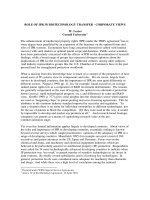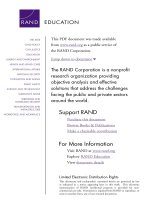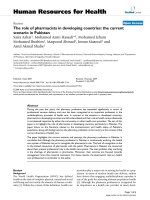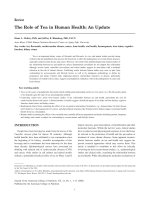Role of pharmacists in clinical risk management
Bạn đang xem bản rút gọn của tài liệu. Xem và tải ngay bản đầy đủ của tài liệu tại đây (3.26 MB, 225 trang )
ROLE OF PHARMACISTS IN CLINICAL RISK
MANAGEMENT
KOH YI LING YVONNE
B. Sc (Pharm)(Hons), NUS
A THESIS SUBMITTED
FOR THE DEGREE OF DOCTOR OF PHILOSOPHY
DEPARTMENT OF PHARMACY
NATIONAL UNIVERSITY OF SINGAPORE
2006
i
Acknowledgements
Although I chose to write this section only after I have completed putting this
thesis together, this is without doubt the most important section of the entire thesis.
This thesis and all the studies it encompass will not have been possible without the
help of many people. I would like to take this opportunity to dedicate this page to the
following people whom I want to express my heartfelt gratitude.
The first person on the list has to be my husband, Chun Wei. Without his
constant support, help, understanding and specks of ideas, as well as his unwavering
love and total belief in me, I would never have pulled through these few years of post-
graduate studies.
Associate Professor Li Shu Chuen, my supervisor and mentor. If not for Prof
Li’s guidance and brilliant mentorship in both studies and non-studies related manner,
this thesis would have been totally impossible. Other than wanting to thank Prof Li, I
would also like to take this opportunity to apologize for all the hair-tearing moments
he had when vetting through my protocols and manuscripts.
The pharmacy manager of Alexandra Hospital, Mdm M K Fatimah, and her
team of dedicated pharmacists – Lee Yee Ming, Teo Hui Ling, Shane Chua and
Sharon Tan. Without their help and participation, the studies carried out in Alexandra
Hospital would not have materialized. Special thanks to Yee Ming who took on the
role of the principal investigator in the study conducted in the in-patient wards. There
were many frustrating moments when logistic problems presented themselves as huge
ii
stumbling blocks which seemed impossible to get around at that time, and not to
mention the hurdles we had to overcome with the DSRB. I am really glad for your
patience and efficiency which saw us through all those obstacles.
The studies on adverse drug reaction algorithms would not have be possible if
not for the help of Ms Chan Cheng Leng (Head of Pharmacovigilance Unit), Miss
Ang Pei San and Miss Tan Bee Him (Regulatory Pharmacists, Pharmacovigilance
Unit) from Centre for Drug Administration, Health Sciences Authority, Singapore, for
their valuable comments, expertise and their help in providing the data required for
the studies.
Last but not least, my deepest appreciation to the National University of
Singapore for granting me the research scholarship which gave me the opportunity to
experience post-graduate study, and the Department of Pharmacy for granting me
Teaching Assistantship. Being a Teaching Assistant had given me the chance to
contribute back to the department where I literally grew up in and also gave me a
conducive environment to complete the last lap my post-graduate studies.
iii
Table of Contents
Acknowledgements i
Table of Contents iii
Summary vii
List of Tables x
List of Figures xii
List of Abbreviations xiii
List of Publications xiv
Chapter 1 Introduction 1
1.1 Overview 2
1.2 Introduction to Drug-Related Problems (DRPs) and Adverse Drug
Reactions (ADRs) 4
1.2.1 Drug-related problems 4
1.2.1.1 Causes of the various DRPs 5
1.2.1.2 Influence of polypharmacy on DRP 8
1.2.1.3 Influence of age on DRP 9
1.2.2 Adverse drug reactions 9
1.3 Work done to date for the management of Drug-Related Problems (DRPs)
13
1.4 Work done to date for the management of ADRs 15
1.5 Why is there a need to assess DRPs and ADRs situation in Singapore? 17
1.6 Research motivations 18
Chapter 2 Therapy Related Hospital Admission in Patients on Polypharmacy in
Singapore: A Pilot Study 23
iv
2.1 Introduction 24
2.2 Method 26
2.3 Results 28
2.4 Discussion 31
2.5 Conclusions 33
Chapter 3 Drug-Related Problems in Hospitalized Patients on Polypharmacy:
The Influence of Age and Gender 34
3.1 Introduction 35
3.2 Methods 38
3.2.1 Study population 38
3.2.2 Definitions 38
3.2.3 Data Collection 39
3.2.4 Classification of DRPs 40
3.2.5 Statistical analysis 41
3.3 Results 42
3.3.1 Characteristic of population 42
3.3.2 Medication profile 42
3.3.3 DRPs during hospital stay 43
3.3.4 ADR analysis 47
3.4 Discussion 51
3.5 Conclusions 56
Chapter 4 The Impact on the Clinical and Economic Outcomes among In-Patients
by a Physicians-Pharmacists Review Team 58
4.1 Introduction 59
4.2 Methods 63
v
4.2.1 Study group 64
4.2.2 Control group 65
4.2.3 Types of interventions 66
4.2.4 Data collection 68
4.2.5 Outcome measures 69
4.2.6 Analysis 70
4.3 Results 76
4.3.1 Average length of Stay 77
4.3.2 Interventions carried out during the study period 78
4.3.3 Costs analysis 80
4.3.4 Sensitivity Analysis 82
4.4 Discussion 86
Chapter 5 Development of a New Algorithm to Identify the Causality of Adverse
Drug Reactions 95
5.1 Introduction 96
5.2 Methods 99
5.2.1 Development of the new algorithm 99
5.2.2 Testing of the new algorithm 103
5.3 Results 105
5.4 Discussion 110
5.5 Conclusion 116
Chapter 6 A Quantitative Approach of using Genetic Algorithm in Designing a
Probability Scoring System for Adverse Drug Reaction Assessment 117
6.1 Introduction 118
6.2 Methods 123
vi
6.2.1 Development of the scoring system 123
6.2.2 Testing of new scoring system 132
6.2.3 Developing of appendix for existing algorithm 135
6.3 Results 136
6.4 Discussion 140
Chapter 7 A Systematic Approach of Identification and Classification of Adverse
Drug Reactions: Alerts Based on ADRs’ Causality and Severity (ABACUS) 144
7.1 Introduction 145
7.2 Methods 151
7.2.1 Approach in Designing the Severity Scoring System 151
7.2.2 Rules for Assigning Severity Scores 152
7.2.3 Constructing the Border between the Different Alert Zones 154
7.2.4 Development of online version of new algorithm 155
7.2.5 Testing of the New Algorithm 155
7.3 Results 156
7.4 Discussion 165
7.5 Conclusion 169
Chapter 8 Overall Conclusion 170
8.1 Major findings 171
8.2 Contributions 178
8.3 Limitations 180
8.4 Recommendations for future studies 182
Bibliography 183
Appendix 193
vii
Summary
The focus of this thesis is on detecting and quantifying drug-related risks faced
by in-patients in Singapore, followed by assessing and managing these risks from the
perspective of a pharmacist. Currently, there are no formal local studies that
investigate specifically into drug related problems (DRPs) and adverse drug reactions
(ADRs) to evaluate the situation and to implement strategies to minimize the
occurrence of these problems. To address the aforementioned conditions, this thesis
attempted to establish the current level of risk that the patients were exposed to in the
healthcare environment, as well as to ascertain the contributory factors for the
increased risk. This was followed by an attempt to evaluate the clinical and
economical impact on increased and systematic involvement by pharmacists in
reducing these risks. Thereafter, a quantitative tool in assessing ADR with the view
that risk of DRPs, namely ADR could be greatly reduced with a better instrument in
an improved healthcare environment.
This thesis found that the DRPs detected in in-patients were mainly avoidable.
With this knowledge of a more exact representation of the situation locally, it would
then be possible to develop and implement strategies which would help in detecting,
assessing and managing the situation of DRPs. This finding led the next step of the
thesis to a follow-up study which studies the impact of regular pharmacist’s
participation in a physician-pharmacist review team. It was shown that with the
presence of a pharmacist in a primary patient care review team, more DRPs (and even
potential DRPs) were detected and were promptly averted. There was significant total
drug cost savings during the study period (linearly projected as $42 000 annually)
viii
when there was a pharmacist on board the review team. The cost-benefit ratio of such
an arrangement was calculated to be 5.84. This positive ratio, on top of a net annual
return of $42 000 in investing in a pharmacist to perform such monitoring tasks
seemed to substantiate the cost-effectiveness for hospital administrators to endorse
such pharmaceutical care services.
After evaluating the inclusion of a pharmacist into the regular ward round as a
change in system to reduce clinical risk to the patients. The next study performed was
to evaluate whether the existing tools for assessing and ascertaining risk is suitable or
sufficient for the pharmacists to carry out the task efficiently. A thorough assessment
of the available tools and the reality of readily available clinical data demonstrated the
necessity to develop a simpler and user-friendlier tool to assist the pharmacists in the
task. In this thesis, a new quantitative ADR causality scale was developed. A severity
assessment scale for comparing the intensities of the severity of various ADRs was
also produced and incorporated with the abovementioned ADR scale. This
amalgamation provides a novel combined ADR causality and severity scoring system
which will serve to give more practical value to the results obtained compared to the
individual causality and severity scores. This scoring system could be utilized to
facilitate ADR signal generation for general drugs or for targeted drugs. Its
quantitative nature can also help clinicians, investigators and the regulatory
authorities in case management when they are faced with limited time and resources.
This scoring system will also be a useful tool for pharmacists in patient care review
team for the purpose of detecting ADRs in the in-patients.
ix
From the results obtained from these studies, it could be inferred that with a
change in the workflow of the current healthcare system in Singapore and by
equipping the pharmacists with user-friendlier tools (e.g. the algorithm developed in
this thesis), it would be possible to allow the pharmacists to play a much bigger role
in contributing to clinical risk management.
x
List of Tables
Table 3.1 Ten most commonly prescribed drugs 43
Table 3.2 Dose of medication too high for existing renal or hepatic function 45
Table 3.3 Significant potential drug interactions 47
Table 3.4 Identified cases of adverse drug reactions 48
Table 3.5 Prevalence rates of developing DRPs and ADRs for the various patient
subgroups 50
Table 4.1 Type of interventions carried out by pharmacists during the study 67
Table 4.2 Calculating cost savings in study group over control group 72
Table 4.3 Calculating hospital charge saving in study group over control group 73
Table 4.4 Calculating the net annual return on investment in one pharmacist 74
Table 4.5 Reasons for eventual exclusion from the study 76
Table 4.6 Patient population in the two groups 77
Table 4.7 Sensitivity analysis of cost-benefit ratio based on drug cost savings 83
Table 4.8 Sensitivity analysis of cost-benefit ratio based on hospital charge savings.
84
Table 5.1 List of “answerable” questions 105
Table 5.2 List of questions with scores for our new ADR algorithm 106
Table 5.3 Cut-off scores for our algorithm 107
Table 5.4 A comparison of the different causality classification of the 450 ADR
reports 108
Table 5.5 Results from comparative study of the various algorithms against
Kramer’s 108
xi
Table 5.6 Comparison of percentage of congruency (%) between the different
algorithms 109
Table 5.7 Actual number of ADR cases with the same causality assignment as that
by Kramer’s algorithm 113
Table 6.1 The eight criteria used in our algorithm 121
Table 6.2 Rules that define ‘Definite’ cases 124
Table 6.3 Rules that define ‘Probable’ cases 125
Table 6.4 ADR cases with known probability values 126
Table 6.5 New scoring system for the algorithm 131
Table 6.6 ADR cases with varying amount of information available 133
Table 6.7 Sensitivity and specificity comparison of various existing algorithms .137
Table 6.8 Appendix for new algorithm 138
Table 6.9 Percentage differences in grading each criterion before and after the
introduction of the appendix (n=50) 139
Table 6.10 Inter-rater agreement of the algorithm 139
Table 7.1 Our new severity assessment scale 156
Table 7.2 Combined ADR causality and severity scoring system 158
Table 7.3 Actual cases to illustrate use of combined causality and severity scoring
system (first part) 163
Table 7.4 Actual cases to illustrate use of combined causality and severity scoring
system (second part) 164
xii
List of Figures
Figure 1.1 Trends of local ADR reporting in Singapore 11
Figure 2.1 Types and frequency of DRPs 29
Figure 3.1 Drug-related problems and their number of incidences identified in
patients during hospital stay 44
Figure 3.2 List of duplicate therapies 44
Figure 3.3 Ten drugs/drug classes that were most likely to be involved in causing
drug–drug interactions 46
Figure 4.1 Therapeutic intervention recording forms used by the pharmacy
department 69
Figure 4.2 Types of intervention performed in the control group (n = 15) 79
Figure 4.3 Types of intervention performed in the study group (n = 180) 79
Figure 4.4 Types of drug related problems prevented in the control group (n = 15)
80
Figure 4.5 Types of drug related problems prevented in the study group (n = 180).
80
Figure 5.1 Categories of various algorithms 98
Figure 5.2 ADR reporting form used by CDA 100
Figure 6.1 Schematic diagram of how genetic algorithm works 128
Figure 7.1 Some severity assessments which define the severity levels used 148
Figure 7.2 Online version of combined scoring system 162
xiii
List of Abbreviations
ABACUS – Alerts Based on ADRs’ Causality and Severity
ADR – Adverse drug reaction
ADRAC – Adverse Drug Reaction Advisory Committee
CDA – Centre for Drug Administration
CI – Confidence interval
DRP – Drug related problem
FDA – Food and Drug Administration
SD – Standard deviation
TGA – Therapeutic Goods Administration
WHO-UMC – World Health Organization-Uppsala Monitoring Centre
xiv
List of Publications
A. Publications relating to research work from the current thesis
1. Koh Y, Yap CW, Li SC. A quantitative approach of using genetic algorithm in
designing a probability scoring system of an adverse drug reaction assessment
system. Int J Med Inform. 2006; Submitted.
2. Koh Y, Li SC. A new algorithm to identify the causality of adverse drug
reactions. Drug Saf. 2005;28(12):1159-1161
3. Koh Y, Kutty FBM, Li SC. Drug-related problems in hospitalized patients on
polypharmacy: the influence of age and gender. Ther Clin Risk Manag.
2005;1(1):39-48.
4. Koh Y, Fatimah BMK, Li SC. Therapy related hospital admission in patients
on polypharmacy in Singapore: a pilot study. Pharm World Sci.
2003;25(4):135-137.
B. Publications from other projects not included in the current thesis
1. Luo N, Koh Y, Tan CH, Kua EH, Li SC. Drug utilization review of
risperidone for outpatients in a tertiary referral hospital in Singapore. Hum
Psychopharm. 2004;19(4):259-264
xv
C. Conference Presentations (Oral Presentation)
1. Koh Y, Fatimah MK, Li SC. Prevalence of drug therapy related hospital
admission and its association with polypharmacy and age of patients in
Singapore. Proceedings of European Society of Clinical Pharmacy 3rd Spring
Conference on Clinical Pharmacy “Pharmaceutical Care: The Hospital -
Primary Care Continuum”, Portorož, Slovenia, 8 - 11 May 2002.
2. Koh Y, Chan CL, Li SC. Comparison of five established adverse drug
reaction algorithms in a patient sample in Singapore. Proceedings of European
Society of Clinical Pharmacy 4th Spring Conference, “Clinical Pharmacy and
the Ageing Patient”, Lisbon, Portugal, May 14-17, 2003.
D. Conference Presentations (Poster Presentation)
1. Koh Y, Fatimah MK, Li SC. Prevalence of drug therapy related hospital
admission and its association with polypharmacy and age of patients in
Singapore. Proceedings of 15th Singapore Pharmacy Congress, Singapore,
November 9-10, 2002.
2. Koh Y, Fatimah MK, Li SC. Prevalence of drug-related problems amongst
hospitalised patients on polypharmacy in Singapore. Proceedings of ISPOR 9
th
Annual Conference, Arlington, West Virginia, USA, May 16-19, 2004. Value in
Health 2004; 7(3): 372.
xvi
3. Koh Y, Yap CW, Li SC. Developing a quantitative scoring system for adverse
drug reaction assessment using genetic algorithm. Proceedings of ISPOR 2nd
Asia-Pacific Conference, Shanghai, China, March 5-7, 2006.
C
C
h
h
a
a
p
p
t
t
e
e
r
r
1
1
:
:
I
I
n
n
t
t
r
r
o
o
d
d
u
u
c
c
t
t
i
i
o
o
n
n
1
Chapter 1
Introduction
C
C
h
h
a
a
p
p
t
t
e
e
r
r
1
1
:
:
I
I
n
n
t
t
r
r
o
o
d
d
u
u
c
c
t
t
i
i
o
o
n
n
2
1.1 Overview
Risk management in the pharmaceutical sense is a term used to describe the
process of actively identifying, assessing, communicating and minimizing the risks
which may arise from using a drug.
1
Ideally, such processes which seek to establish
and maintain a favorable benefit-risk balance in patients should take place at different
stages of the life-cycle of a drug, from its development all the way to post-marketing
surveillance of the drug used in the general population. Although drugs are meant to
provide patients with relatively predictable beneficial effects, unfortunately they also
have the potential to cause unexpected and unwanted effects. These unwanted effects
may range from minor side effects to major debilitating effects, or in the worse case
scenario, fatal consequence.
The term drug-related problems (DRPs) is used to describe these
consequences which are different from the intended pharmacotherapeutic effect of the
drugs involved.
2
However, this is only a brief and simplistic summary of what DRPs
encompass. According to Strand et al.,
3
DRPs would include the following eight
broad categories - adverse drug reactions (ADRs); untreated indication; drug use
without indication; improper drug selection; using subtherapeutic dose of drug;
excessive dose of a correct drug; drug interaction; and failure to receive drug.
The focus of this thesis is on detecting and quantifying these drug-related risks
faced by in-patients in Singapore, followed by assessing these risks and managing
them from the perspective of a pharmacist. In this chapter, an introduction to DRPs
and ADRs would be provided (Section 1.2), followed by a brief review of work done
to date for the management of DRPs and ADRs (Sections 1.3 and 1.4 respectively).
C
C
h
h
a
a
p
p
t
t
e
e
r
r
1
1
:
:
I
I
n
n
t
t
r
r
o
o
d
d
u
u
c
c
t
t
i
i
o
o
n
n
3
Thereafter, the rationale to assess the DRP and ADR situation in Singapore would be
discussed (Section 1.5). With this in place, a list of research motivations is then
generated (Section 1.6). These questions will be examined in the subsequent chapters
with each chapter detailing the methodology, results and discussion of the individual
studies embarked upon to answer each issue with the hope that the summation of the
study results would shed some lights as how to minimize and manage drug-related
risks from the perspective of a pharmacist.
C
C
h
h
a
a
p
p
t
t
e
e
r
r
1
1
:
:
I
I
n
n
t
t
r
r
o
o
d
d
u
u
c
c
t
t
i
i
o
o
n
n
4
1.2 Introduction to Drug-Related Problems (DRPs) and Adverse
Drug Reactions (ADRs)
1.2.1 Drug-related problems
As briefly mentioned earlier, DRPs which include adverse drug reactions
(ADRs), unnecessary drug therapy, inappropriate choice of drugs, and untreated
conditions, have been shown to prevail in hospitalized patients, with a reported
incidence rate as high as 25%.
4, 5
Due to their association with increased rates of
morbidity and mortality, DRPs continue to be a major problem faced by healthcare
institutions worldwide.
2, 6-8
Inappropriate prescribing of medications, ADRs and drug
interactions may cause increased morbidity and mortality, and treating these
iatrogenic complications further burdens the health care system.
6
This is in view of
patients requiring more nursing care, more attention by the attending physician, and
possibly additional drugs to treat the resulting adverse reaction or interaction.
7
All
these inevitably lower the quality of life of the patient. Moreover, the extent and cost
of drug related morbidity and mortality are of great importance to health care
practitioners, administrators, patients and society as a whole.
2
Many factors can contribute to the high prevalence rate of DRPs, but among
these factors, polypharmacy and older age have often been identified as important risk
factors.
4, 9, 10
C
C
h
h
a
a
p
p
t
t
e
e
r
r
1
1
:
:
I
I
n
n
t
t
r
r
o
o
d
d
u
u
c
c
t
t
i
i
o
o
n
n
5
1.2.1.1 Causes of the various DRPs
As stated earlier in this chapter, there are 8 different types of DRPs. These are their
associated causes, adapted for use in this dissertation
11
:
1. Adverse drug reaction
a. The drug was administered too rapidly for this patient
b. The patient is having an allergic reaction to this medication
c. The patient has identified risk factors that make the administered drug
too dangerous to be used
d. The patient has experienced an idiosyncratic reaction to the
administered drug
2. Untreated indication
a. The patient has a new medical condition requiring initiation of new
drug therapy but not receiving the drug
b. The patient has a chronic disorder requiring continuation of drug
therapy but is not receiving it
c. The patient has a medical condition that requires combination
pharmacotherapy to attain synergism/potentiation of effects
d. The patient is at risk to develop a new medical condition preventable
by the use of prophylactic drug therapy and/or pre-medication
3. Drug use without indication
a. The patient is taking a medication for which there is no valid medical
indication at this time
b. The patient accidentally or intentionally ingested a toxic amount of a
drug or chemical, resulting in the present illness or condition
c. The patient’s medical condition is better treated with non-drug therapy
C
C
h
h
a
a
p
p
t
t
e
e
r
r
1
1
:
:
I
I
n
n
t
t
r
r
o
o
d
d
u
u
c
c
t
t
i
i
o
o
n
n
6
d. The patient is taking multiple drugs for a condition for which only
single-drug therapy is indicated
e. The patient is taking drug therapy to treat an avoidable adverse
reaction associated with another medication
4. Improper drug selection
a. The patient has a medical problem for which the administered drug is
not effective
b. Patient is allergic to the administered medication
c. Patient is receiving a drug that is not the most effective for the
indication being treated
d. The patient has risk factors that contraindicate the use of the
administered drug
e. The patient is receiving a drug that is effective but not the least costly
f. The patient is receiving a drug that is effective but not the most safe
g. The patient has an infection involving organisms that are resistant to
the administered drug
h. The patient has become refractory to the present drug therapy
i. The patient is receiving an unnecessary combination product when a
single drug would be appropriate
5. Subtherapeutic dose
a. The dosage used is too low to produce the desired response for this
patient
b. The patient’s serum drug concentrations are below the desired
therapeutic range
C
C
h
h
a
a
p
p
t
t
e
e
r
r
1
1
:
:
I
I
n
n
t
t
r
r
o
o
d
d
u
u
c
c
t
t
i
i
o
o
n
n
7
c. Drug, dose, route, or formulation conversions were inadequate for the
patient
d. Dose and interval flexibility (insulin sliding scales, “as needed”
analgesics) were inadequate for the patient
6. Excessive dose
a. Dosage is too high for the patient
b. The patient’s serum drug concentrations are above the desired
therapeutic range
c. The patient’s drug dose was escalated too rapidly
d. The patient has accumulated drug from chronic administration
e. Drug, dose, route, formulation conversions were inappropriate for the
patient
f. Dose and interval flexibility (insulin sliding scales, “as needed”
analgesics) were inappropriate for the patient
7. Drug interaction
a. The bioavailability of the drug is altered due to an interaction with
another drug or food the patient is taking
b. The effect of the drug has been altered due to enzyme
inhibition/induction from another drug the patient is taking
c. The effect of the drug has been altered due to displacement from
binding sites by another drug the patient is taking
8. Failure to receive drug
a. The patient did not receive the appropriate drug regimen because a
medication error (including prescribing, dispensing, administration or
monitoring) was made
C
C
h
h
a
a
p
p
t
t
e
e
r
r
1
1
:
:
I
I
n
n
t
t
r
r
o
o
d
d
u
u
c
c
t
t
i
i
o
o
n
n
8
b. The patient did not comply (adherence) with the recommended
directions for using the medication
c. The patient did not take the drug as directed owing to the high cost of
the product
d. The patient did not take the drug as directed because of lack of
understanding of the directions
e. The patient did not take the drug as directed because it would not be
consistent with the patient’s health beliefs
1.2.1.2 Influence of polypharmacy on DRP
Polypharmacy is defined as the use of multiple medications by a single patient
and is commonly observed among geriatric patients.
4
The use of multiple medications
has been shown to predispose patients to ADRs,
10, 12-15
drug-drug interactions,
4, 16, 17
and medication non-compliance,
18-20
particularly in the geriatric population.
Besides the undesirable clinical consequences for the patients, DRPs (mostly
ADRs) also pose a significant financial burden to the healthcare system.
6
In a US
study performed in 1992–1994, the estimated cost of treating reported adverse drug
events among in-patients was US$1.5 million per year at a university-affiliated
hospital.
21
Another more recent French study conducted in 1996–1997 showed the
annual cost of drug-related hospital admission to a university hospital as €3.85 million
per year.
22
Thus, reducing the use of unnecessary medicines and avoiding
polypharmacy would be beneficial in aiding the reduction of healthcare cost beyond
the confine of reduction in drug costs alone.









